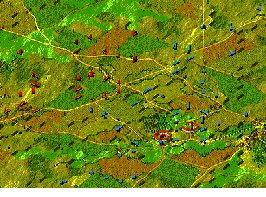 moving all of the routed and disordered Battalions into place and given the rank of Major. –
promotion comes quickly at the front.
moving all of the routed and disordered Battalions into place and given the rank of Major. –
promotion comes quickly at the front.With my unit (the Loyal Lincolnshire Volunteers) resting at Brussels, I ventured forward to Waterloo to see if I could be of use in the upcoming battle against Napoleon. I had been introduced to Lord Wellington by an uncle and felt sure he would welcome me. On arrival I found the French fully deployed opposite our forces and saw Captain David Guegan in the French HQ. I knew this officer to be from the 2e Brigade, 11e Division d'Infantrie, III Corps and thought highly of him. He would surely be performing the same duties as I.
Initially I saw French Lancers riding fast towards Gen Chasse's Division, a whole Brigade of them in fact. The Dutch-Belgians changed into square and this was enough to ward off the impending charge. Then the entire French line surged forward, with Gen Bonaparte's 6th Division attacking the area around Hougoumont. Our brave men held them out of the orchards, but not for very long. In the west, Chasse was ordered to close on the French attacking Hougoumont and encountered the French Lancers in dead ground. Many of these horsemen were quickly picked off by Dutch marksmen before they could ride off. Finally the Coldstream Guards were sent forward to support Hougoumont along with the 4th British Brigade under Mitchell. Beyond this, Wellington gave few orders.

Situation at 09:15 18 June 1815 - Hougoumont
The situation in the west was just as hectic with Papellote Farm besieged with cavalry seen heading east in great numbers. To counter this Vandeleur and Vivian's Cavalry Brigade were dispatched to the crossing at the Chevel de Bois, while Best and his men were sent forward to reinforce the orchard above Papelotte.
Gen Collaert and his entire Dutch-Belgian Cavalry Division were sent east to assist in that wing's defence. The French 4th Division under Durutte assaulted Smohain driving the Orange-Nassau from the town. It was now that the Guard were seen to be heading east en masse.
Disaster then struck as several Bns of the 4th British Brigade fled the line after constant French fire. This opened a gap above Hougoumont and the French 9th Division poured through surrounding Hougoumont. Scores of skirmishers flooded the orchards and prepared to attack Hougoumont, which had its garrison reduced to 2 companies from the 2nd Nassau Regiment due to the Guards moving out to assist with holding the line.
This also left Generals Cook, Byng and Maitland exposed to enemy capture, although this was initially overlooked. General Byng became the first British officer to leave the battlefield under French escort.

It was obvious that Napoleon needed to take the chateau in order to reach the heights above. Till now we had resisted moving any more units into the fracas.
Defences in the far west were fast becoming untenable as the French Cavalry crossed the creek with the victorious 4th Division in support and the French Guard approaching from the southeast. Many Battalions had run from the initial French assaults and the line was held by low-morale troops.

Situation in the west at 09:30 - Papelotte
A brilliant counter-charge by the 6th Cavalry Brigade halted the French breakout from the creek.
Till now casualties were relatively light for both sides but this was about to change for the British. The 6th and 4th Cavalry Brigades became cut off and surrounded by troops when attempting to push the French cavalry back across the creek. Then news reached Wellington that skirmisher units, far in front of their own Battalions had scaled the hills above Papelotte and captured General Perponcher along with a wagon full of gin ! Although the enemy were quickly repulsed the loss of this commander, and the gin, was devastating to morale.
The British lines held for half an hour before the French decided to launch their major thrust in the west. The French feint around Hougoumont had worked and vital reinforcements needed in the west were held back at La Haye Sainte. The French Guard surged from the creek line supported by the 3rd and 4th Divisions and several Cavalry Divisions. What was left of Vivian's and Vandeleau's commands were quickly overwhelmed with losses reaching 2,000 horse. General Best and his command routed leaving huge gaps in our western defence. As I sat amongst the Staff Officers, I could see French troops swarming towards our position encountering little opposition. Still it could have been worse as the massed French Cavalry did not charge, for if they had then all of our cavalry would have been run down.
With Lord Uxbridge busy attempting to rally the 3rd and 5th Cavalry above Hougoumont, it was left to General Collaert to stop the French advance. Wellington was busy looking at the situation around Hougoumont to fully grasp the seriousness of the French break through. With the Chateau surrounded and the troops inside routing, a counter attack was critical. During one of the many skirmisher assaults around the chateau, General Maitland was unhorsed and captured – another blow to the depleted Guards. General Chasse still had not moved forward for fear that his troops would be run down by the ever present French Cavalry.
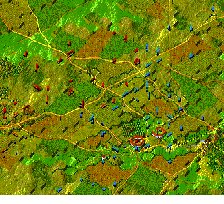
Situation prior to Allied Movement
In the west a mighty cavalry battle took place resulting in Allied cavalry losses growing to 3,000.
General Ghigny was surrounded and his command destroyed. Although the British had pushed the
French back across the entire front, their losses and growing fatigue were a major concern. The
artillery ammunition was also running low, having used half their entire supply already. I was
given the task of rallying the 8 battalions still routed in the rear and promoted to Captain for my
efforts. On his return from Hougoumont, Wellington ordered that the units in the west would retire
to the woods east of the Mont St Jean farm. The cavalry, under Collaert was given the task of
holding the French Battalions until a new defensive line could be constructed. I was tasked with
 moving all of the routed and disordered Battalions into place and given the rank of Major. –
promotion comes quickly at the front.
moving all of the routed and disordered Battalions into place and given the rank of Major. –
promotion comes quickly at the front.
Situation after Allied movement
In the west our troops were holding the line although suffering increased routing due to high fatigue. Indeed the garrison in Hougoumont dropped to 50 men through routing and the constant French assaults.
With their troops halted in the west, the French commanders launched a major assault in the west hoping to trap the British cavalry and destroy it in total.
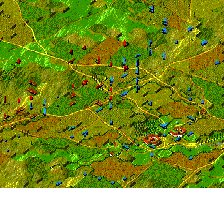
Situation after French assault
They were partially successful as shown above. The last of the 6th Cavalry Brigade and the Dutch Heavies were surrounded and rescue prospects looked bleak. Seeing that the Cavalry alone could not stop the French, Wellington ordered the Brunswicks to make great haste from the far western flank to the new defence line in the east. With Major General Johnstone due at 12:00 and Major General Lyon not far behind, our lines in the east would only have to hold for a short time until these fresh Battalion could drive the French back. Wellington was also expecting the Prussians to arrive around the same time and they would enter the battleground at the rear of the French assault.
At 11:15 the French launched yet another major assault on our left flank punching several holes in our line. Our cavalry tried their best to hold the marauding Cuirassiers but with casualties reaching over 4,500, the battle was swinging away from us. The French cavalry were in our rear with nothing to stop them exploiting past Mont St Jean, cutting the road to Brussels. The entire left flank was in danger of being cut off and destroyed. With this prospect occupying the commander's minds, the garrison at Hougoumont was not reinforced after falling to 25 men. The French seized upon this fact and cut off all means of entry to the Chateau ensuring its demise.
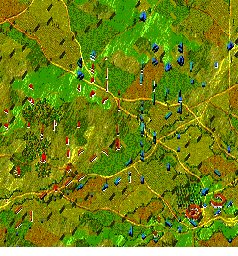
Situation before British charge
Every available horse was mustered under Collaeart (Uxbridge was attempting to rally Ponsonby's Brigades) for a last ditch charge into the French Lancers. I was given the task of organising Battalions to cut off the French escape as well as giving cover from a possible counter charge. As the dust settled after 2,000 horse had charged past us, we were victorious with all the French units destroyed. Alas, as we prepared to reorder and consolidate our lines the French formed up for another epic charge……thousands of men on horseback…….the remains of once proud Brigades of Cavalry strewn across the battlefield….the sound of the Guard marching towards us…..then without warning the French Battalions emerged from the smoke and dust to descend upon us. All chance of retreat was gone when we heard the heavy sound of thousands of hooves charging behind us.
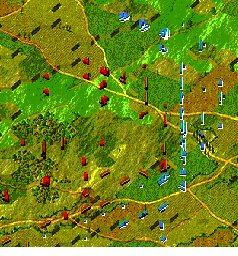
French form up for massed charge
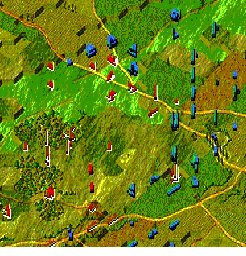
Results of French assault.
The French Battalions were victorious in their melees but the French Cavalry did not fare as well. This was perhaps one of the turning points in the battle – the French advance was stopped !! But at a price – 5,500 Cavalry were gone and the French still had not committed all of the guard. It was then that we realised that General Best and 1,400 troops were surrounded. The Brunswicks were still 30 minutes from supporting the left flank, as were our reinforcements. We had merely delayed the French advance…….now Wellington decided that this would be the critical phase in the battle…..rather than retreat, we would fight. All horse were brought forward up to the enemy (no charging here as the ground was too thick with the dead and wounded). The Line Battalions of the Brunswicks were brought forward at the double march to cover our rear should this assault fail.
Ponsonby's reserve was positioned to force a path through to the besieged battalions. If this assault did not work then our troops would be strung out and defenceless and our cavalry exhausted. Wellington gambled on one last push to stop the French advance or everything would be lost. Hougoumont was now empty and no clear path to re-enter the chateau……after the great defence put forward, the French could now just walk in and claim their prize. I took control of the shattered 5th Hanoverian Brigade as a Lt Colonel and positioned these routed troops to the rear as a last ditch reserve.


As the frenzy of battle settled it was clear that we had won a most bloody victory. Thousands of French horse killed and our Battalions could now escape. After uninterrupted cavalry charges the toll now stood at 6,000 French and 5,700 Allied – the first time that we had suffered less than the enemy. Only 6 of our officers had fallen to 14 French commanders killed or captured (almost all of them cavalry corps). Wellington tempered our joy with the sobering thought that we had not encountered the Guard. Although we had smashed the best of the 4th and 3rd Divisions, Napoleon now sent his 1st and 2nd against our depleted centre.
With the lines now firming, the French threw wave after wave of Battalions and cavalry against the Brunswicks to no avail. The centre buckled around La Haye Sainte and the French actually took the heights for a short period but were eventually beaten back. In the west, Wellington realised that the forces to the front of our right flank must be thin with little depth and were prime for a break through. I was promoted to full Colonel and sent to assist General Chasse to advance and move to engage the French Cavalry to his front. The 3rd and 4th British Brigades prepared to advance, supported by Colonel Halkett's Hanoverians.
The first elements of the Prussians arrived and harassed the waiting French in the Bois de Paris. Wellington sent word for the Prussians to stay hidden and to keep the French guessing as to their strength and intentions. To this end the Prussians would first show in the south and next in the north, constantly moving Battalions back and forth. This ploy appeared to work when the French detached many Cavalry units to the supposed Prussian position.

Situation before the Allied attacks
The battle lines shifted little over the next few hours with the exception of the south-west where Chasse and his Division was attempting a break through. Supported by Lyon's fresh troops, the Dutch-Belgians moved into a position close to the waiting French. Hidden by terrain, I moved the 7th Cavalry Brigade down from the ridge ready to charge the flank of the French 6th Division. I then ordered the Guard moved from their secure position, fully rested with low fatigue, and prepared to retake Hougoumont. The attack spanned three turns and at the end, the French left flank was crushed, leaving their rear completely open. I ordered all available forces through the gaps and caught many routed units inflicting many casualties.
The French lasted until 5:00pm before they retired towards Paris. Wellington and Blucher decided that their casualties were too severe to pursue. For my role in the final decisive series of assaults I was promoted to Brigadier General.

Situation after the last assault.
Final casualties are presumed to be:
Infantry 49,125
Cavalry 13,775
Artillery 195
Officers 96
Infantry 36,150
Cavalry 11.350
Artillery 51
Officers 15
It was agreed that this was a very close run thing and only a handful of decisive moments saved the day for the Allies. Running short of ammunition by 10:00 am played a crucial part in our defence, however it must be stated that the French also ran out of ammunition and this is one of the reasons for their stalled offensive.
It is evident that the successive cavalry charges high on the ridge in the east were the turning points in the entire battle. If we had not won that series of engagements then all would have been lost long before the Prussians arrived. The arrival of the Brunswickers helped stop the rampaging French Guard and if not for their dogged defence the left flank and rear would have been lost. Finally, General Chasse and his Dutch-Belgians, with their low morale and reputation for running, were another decisive factor in breaking the French will to continue.
As more Prussians entered the field of battle the tide had turned against the French and they chose an honourable exit from Waterloo. Major David Guegan must be recognised for his tactical employment of the Guard and his cavalry, who were most unlucky not to prevail. Had the tide of battle turned the other way he would have been paraded in Paris this day.